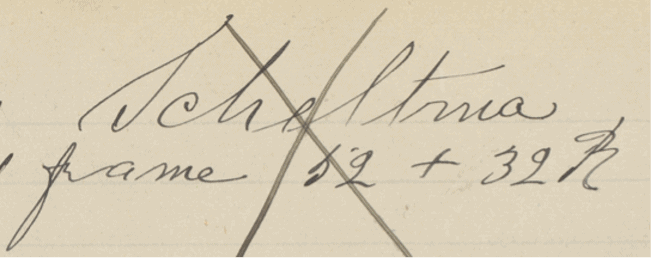Thallon’s Ledger 1888/89 – 1903: A guide to using the transcription
Thallon’s ledger was transcribed in 2020 by Bella Lipson-Smith and Dominic King from a photocopy of the original ledger owned by Jarman Framing. Editing was undertaken by Holly McGowan-Jackson.
Accuracy of the transcription
- While every effort was made to transcribe accurately, the different writing styles and reduced clarity of the photocopy sometimes made the interpretation difficult. It is recommended to refer to the digitised entry for confirmation.
Dating of entries
- Ledger entries include the month and day but generally not the year, although they are sometimes written on payment dates or at the start of a new year.
- Where a year is included in the text, this is noted in the Research note.
- The ledger is arranged alphabetically by client, and was added to over several years, so the sequence of years is not always clear.
- Where it was not possible to infer the sequence of years with confidence, the term circa written “c.YYYY” or “c.YYYY-YYYY” (for a date range) was used.
Transcription conventions
- Curved brackets ( ) denote transcription notes, such as (?) after an uncertain word.
- Square brackets [ ] denotes a circled word or an interjection in the original text, e.g. “gold flats 1 3/4 [flat] to show” (see below).
- Forward slash / with a space either side denotes a new line or gap in writing.
- _ denotes illegible character/s.
- The main entry information and the accompanying address contain direct quotes from the text.
- Generally, dimensions listed in entries are presented separately, underneath the main entry information. The metric conversion has been added to the transcription. If known, the type of dimension is indicated: either Rebate (R), Sight (S) or External (E) dimensions. Sometimes dimensions were left in the main entry information where they aid understanding.
- Where Client/Artist names have been misspelt in the ledger, the correct spelling has been put in the transcription. When variations of a client name have been used, if the meaning is clear, the most common variation has been included.
- The Date, Dimensions, and Price fields contain information included in the text but are not direct quotes. Where a direct quote includes useful information (such as a year included in the date, or other dimension notes), the quote this has been included in the main entry information or the research note.

Sketches
- For entries with sketches, further information is provided in ‘Member width’, ‘Frame sketch type’, and ‘Frame sketch main features’ fields.
Common shorthand and abbreviations in the ledger
- ‘Mo’ — Short for ‘moulding’. Thallon’s framing business utilised a numerical system to refer to different timber mouldings or profiles. The ledger does not include a guide to which numbers refer to which profile shapes, but this could be inferred with further research.
e.g.: 1 frame no 20 mo with 2” flat.
- ‘Do’ or ‘D—’ — Abbreviation of ‘ditto’, meaning ‘the same thing again’, which appears throughout the ledger to avoid repetition. This shorthand form is no longer common in Australian English.
e.g.: Do 1 — 1 ½” flat.
- ‘R’ – A decorative capital ‘R’ after measurements signifies rebate dimensions. This indicates the size of the frame opening from the back, including the recess at the frame’s inside edge, on which the painting or mount rests. See example below:

- ‘Exh’ — Short for ‘Exhibition’.
e.g.: Forwarding 1 picture to Exh.
- ‘Sup’ — Short for ‘Supplying’.
e.g.: Sup gilt mount for 1 frame.
- ‘Alh’ — Short for ‘Alhambra’, a style of frame.
- ‘Eng’ — contextually short for ‘Engraving’ or ‘English’.
e.g.: Framing 1 Eng. In small mo.
1 frame with Eng. Compo.
- ‘/’ used to indicate shillings e.g. “6/3” would be 6 shillings 3 pence.
- ‘ denotes feet and “ denotes inches.
For further information see below, ‘Glossary of terms’ and the essay ‘Exploring frames and framing in late 19th century Melbourne through Thallon’s ledger 1888/89-1903’.
Client information
Click on a client’s name in the transcription to access biographical information, and an overview of frames and/or services provided by Thallon for that client
Further reading
NSW State Archives & Records, Handwriting – tips for reading handwritten documents, https://mhnsw.au/guides/handwritten-documents/ accessed 14 July 2023.